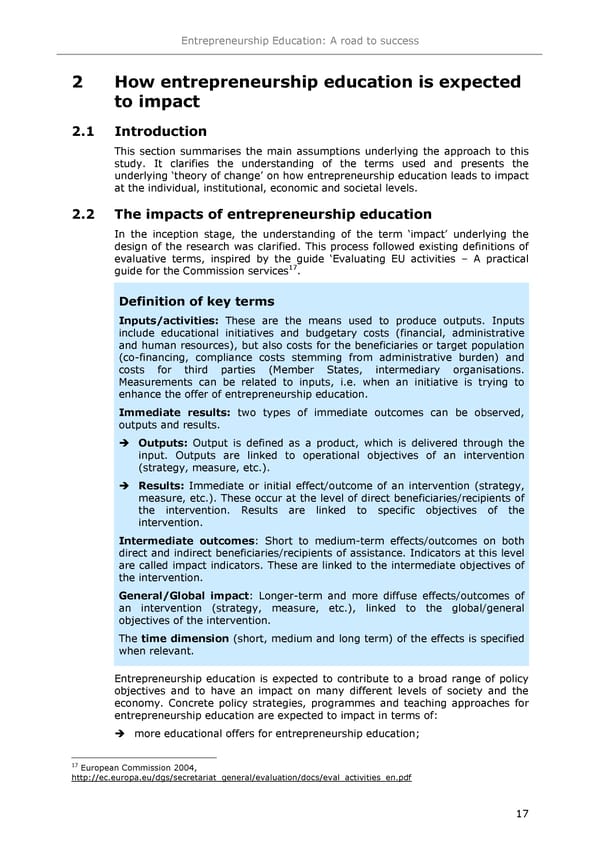Entrepreneurship Education: A road to success 2 How entrepreneurship education is expected to impact 2.1 Introduction This section summarises the main assumptions underlying the approach to this study. It clarifies the understanding of the terms used and presents the underlying 8theory of change9 on how entrepreneurship education leads to impact at the individual, institutional, economic and societal levels. 2.2 The impacts of entrepreneurship education In the inception stage, the understanding of the term 8impact9 underlying the design of the research was clarified. This process followed existing definitions of evaluative terms, inspired by the guide 8Evaluating EU activities 3 A practical guide for the Commission services17. Definition of key terms Inputs/activities: These are the means used to produce outputs. Inputs include educational initiatives and budgetary costs (financial, administrative and human resources), but also costs for the beneficiaries or target population (co-financing, compliance costs stemming from administrative burden) and costs for third parties (Member States, intermediary organisations. Measurements can be related to inputs, i.e. when an initiative is trying to enhance the offer of entrepreneurship education. Immediate results: two types of immediate outcomes can be observed, outputs and results. Outputs: Output is defined as a product, which is delivered through the input. Outputs are linked to operational objectives of an intervention (strategy, measure, etc.). Results: Immediate or initial effect/outcome of an intervention (strategy, measure, etc.). These occur at the level of direct beneficiaries/recipients of the intervention. Results are linked to specific objectives of the intervention. Intermediate outcomes: Short to medium-term effects/outcomes on both direct and indirect beneficiaries/recipients of assistance. Indicators at this level are called impact indicators. These are linked to the intermediate objectives of the intervention. General/Global impact: Longer-term and more diffuse effects/outcomes of an intervention (strategy, measure, etc.), linked to the global/general objectives of the intervention. The time dimension (short, medium and long term) of the effects is specified when relevant. Entrepreneurship education is expected to contribute to a broad range of policy objectives and to have an impact on many different levels of society and the economy. Concrete policy strategies, programmes and teaching approaches for entrepreneurship education are expected to impact in terms of: more educational offers for entrepreneurship education; 17 European Commission 2004, http://ec.europa.eu/dgs/secretariat_general/evaluation/docs/eval_activities_en.pdf 17
 Entrepreneurship Education Page 20 Page 22
Entrepreneurship Education Page 20 Page 22